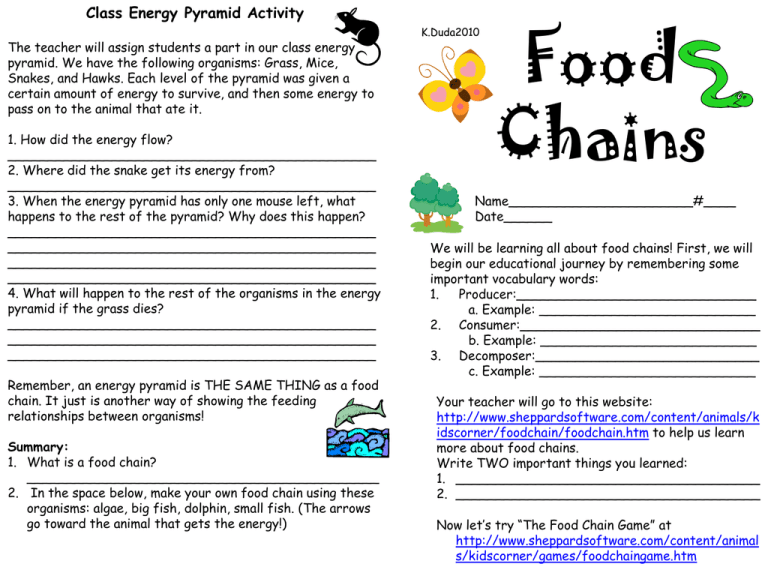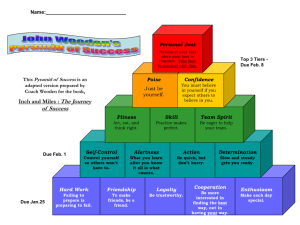Food Chains activity sheet
advertisement

Class Energy Pyramid Activity The teacher will assign students a part in our class energy pyramid. We have the following organisms: Grass, Mice, Snakes, and Hawks. Each level of the pyramid was given a certain amount of energy to survive, and then some energy to pass on to the animal that ate it. 1. How did the energy flow? ______________________________________________ 2. Where did the snake get its energy from? ______________________________________________ 3. When the energy pyramid has only one mouse left, what happens to the rest of the pyramid? Why does this happen? ______________________________________________ ______________________________________________ ______________________________________________ ______________________________________________ 4. What will happen to the rest of the organisms in the energy pyramid if the grass dies? ______________________________________________ ______________________________________________ ______________________________________________ Remember, an energy pyramid is THE SAME THING as a food chain. It just is another way of showing the feeding relationships between organisms! Summary: 1. What is a food chain? ____________________________________________ 2. In the space below, make your own food chain using these organisms: algae, big fish, dolphin, small fish. (The arrows go toward the animal that gets the energy!) K.Duda2010 Food Chains Name_______________________#____ Date______ We will be learning all about food chains! First, we will begin our educational journey by remembering some important vocabulary words: 1. Producer:______________________________ a. Example: ___________________________ 2. Consumer:______________________________ b. Example: ___________________________ 3. Decomposer:____________________________ c. Example: ___________________________ Your teacher will go to this website: http://www.sheppardsoftware.com/content/animals/k idscorner/foodchain/foodchain.htm to help us learn more about food chains. Write TWO important things you learned: 1. ______________________________________ 2. ______________________________________ Now let’s try “The Food Chain Game” at http://www.sheppardsoftware.com/content/animal s/kidscorner/games/foodchaingame.htm A change in the size of one population in a food chain will affect other populations. This interdependence of the populations within a food chain helps to keep the balance of plant and animal populations within a community. For example, look at the Grassland Biome below. When there are too many grasshoppers, there won’t be enough grass for all of them to eat. Many grasshoppers will starve and die. Fewer grasshoppers means more time for the grass to grow. Fewer grasshoppers also means less food is available for the rats to eat and some rats will starve to death. That will lower the populations of the snakes and the hawks. When there are fewer rats, snakes, and hawks, the grasshopper population will increase. The above energy pyramid shows many trees & shrubs providing food and energy to giraffes. As we go up, there are fewer giraffes than trees and shrubs and even fewer lions than giraffes. As we go further along a food chain, there are fewer and fewer consumers. You must have a lot of living things at the base because it has to support a few at the top. Many herbivores are needed to support a few carnivores. Most food chains have no more than four or five links. There cannot be too many links in a single food chain because the animals at the end of the chain would not get enough food and energy to stay alive. Most animals are part of more than one food chain and eat more than one kind of food in order to meet their food and energy needs. 1. Why do you think we say that plants and animals are interdependent in an ecosystem? _______________________________________________ _______________________________________________ _______________________________________________ 2. Why is it important to have more plants at the bottom and a few animals at the top of an energy pyramid? _______________________________________________ _______________________________________________ _______________________________________________ 3. What will happen to the white sharks if there is a low population of seals? ________________________________________________________ 4. What could happen to the phytoplankton if there is a lot of zooplankton? ________________________________________________________ ________________________________________________________ 5. What could happen to the rest of the food chain if there isn’t enough algae in the pond biome? ________________________________________________________ ________________________________________________________ ________________________________________________________











